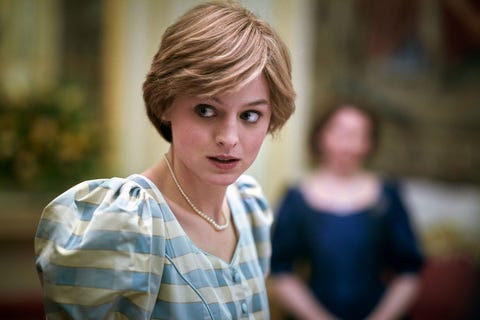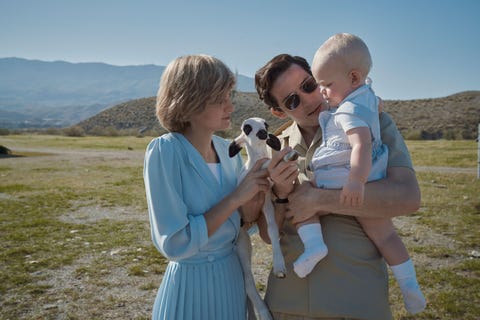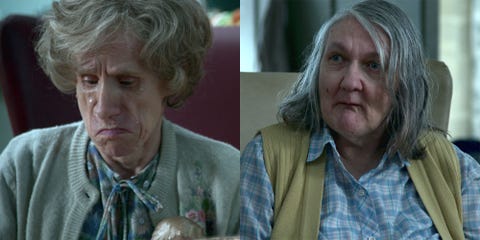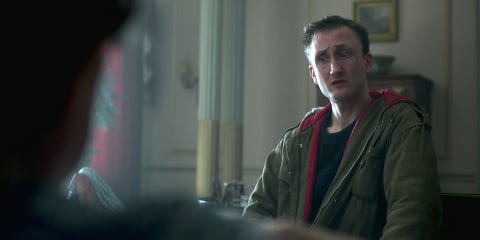Casting announcements for The Crown are almost as exciting as the premiere of a new season itself. Half the fun of the show is analyzing the actors set to portray famous
figures like Princess Diana and Margaret Thatcher, as well as who will next fill the storied shoes of Queen Elizabeth. Peter Morgan’s royal drama is cast by Nina Gold and Robert Sterne, who've won several Emmys for their work on it (they were also responsible for the influx of talent we saw on Game of Thrones). Unsurprisingly, casting The Crown poses specific challenges not experienced on any other show.
“It’s not only that you’ve got to find actors who can successfully embody real-life, well-known people, but you’ve got to make sure there’s a continuity as it’s passed from the younger to the older version of the actor,” Sterne tells ELLE.com. “Who’s done it before, who’s doing it after, and who are the real people?”
Sterne, who's currently in the process of re-casting the entire series for seasons 5and 6, adds, “It’s nerve-wracking because people invest in the original people. You do X hours of screen time with them and fall in love with their interpretation, and then you go again [and re-cast] every two years.”
Sterne and Gold start the casting process for each season about a year before filming begins, meeting with Morgan to learn where the characters will be in their journeys the following season. There were 262 speaking characters in season 4, and Sterne personally worked on all of them. The casting director notes that “you’ve got to think ahead of the game,” and that there are several factors to consider—not just whether the actor looks like the real-life person.
“They’ve got to have some credibility, physically, to be the people they’re supposed to portray,” Sterne notes. “But at the same time, they’ve got to get the spirit of it right.” Below, Sterne breaks down the behind-the-scenes process of building the cast of The Crown.
Perfecting Princess Diana

“Diana was a big deal,” Sterne says, confirming the role has been The Crown’s biggest casting challenge to date. “It was clear as we were heading into the 1980s that she was going to be a major part of it. And we’re starting with Diana at the beginning of her life—we’re not trying to find the icon of the Mario Testino images.”
The casting team embarked on an international search for the person who would play Diana, looking at hundreds of possible actresses in the U.S., U.K., and Australia. They weren’t just auditioning professional actors, either. “It was completely open,” Sterne notes. “We were going into schools in the home countries to see if there was anybody who might be good, since we meet her at 16, as well as looking at people who'd done a lot more work.”
The massive search brought them back to Emma Corrin, whom Sterne had seen in the casting process for season 3. The tense lunch between Camilla Parker-Bowles (Emerald Fennell) and Diana in the third episode of season 4 was used as the audition scene for Camilla—and Corrin came in as a reader to stand in for the part of Diana.
“I usually read in all these meetings, but we decided because it was this major scene that we would get somebody to come in [for Diana],” Sterne explains. “We asked Emma to come in, not thinking about casting Diana at this point. But as she was reading with these Camillas, all the directors and the showrunner were looking more at her and not at the people playing Camilla—who will remain nameless, of course. When we got to thinking about Diana a year later, there she was in my notes.”
Bringing in Margaret Thatcher

Sterne was told early on that the big focus for season 4 would be the three main women: the queen, Diana, and Margaret Thatcher. Casting Thatcher, who has been portrayed repeatedly onscreen in the past, was unusual, because actress Gillian Anderson is Morgan’s partner, and the creator himself approached her about the role.
“There was always a list of one,” Sterne says. “We had thought of ideas and talked it through a lot, but we always knew Gillian Anderson was totally amazing. It seemed like a fresh and interesting way of going. We were very lucky she said she’d do it—she’s such a clever character actress.”
While Anderson is a fairly big name, Sterne and Gold aren’t always looking for an A-list star to be part of The Crown. Having someone like Anderson come in is balanced by casting lesser-known actors like Corrin.
“One of the great joys of working on it—and working with Peter Morgan on it—is that we’re open, and it’s a really genuine opportunity to find the best person for the part,” Sterne says. “We get to find the actor we believe has the best skills and the best instinctive connection with the part, rather than feeling like we’ve got to provide big names all the time.”
Carrying Charles Through

“He’s so three-dimensional,” Sterne explains of the role of Prince Charles. “There are so many aspects to that character. He would have to go on a journey.” It was important that the actor could evolve over a two-decade period, playing both a young version and the one who closes out season 4.
Josh O’Connor's work in Francis Lee’s 2017 film God’s Own Countryled Sterne to cast him as Prince Charles. “He totally inhabited the role in God’s Own Country in this beautiful performance that’s very different from who he is. We thought, ‘Gosh, if that guy can do that and run with a character who’s so different than himself, then that will be interesting to see.’ As soon as we started [working with] him, it became pretty clear it was Josh.”
O’Connor has the obvious physical similarity to Charles, particularly in the ears, but Sterne really wanted someone who could make the role their own and not just mimic a famous figure—something especially important to season 4’s arc.
“It’s really important that you’re not getting an impersonation,” Sterne notes. “They have to embody them. We have an amazing team who help with the voice work and the movement work—those technical aspects—but you want somebody who has the skill to take on all that technically, and then leave it all behind. Josh flew with that from the moment he came into the room.”
Finding Young William and Harry

Princes William and Harry make their debut in season 4 as young children, and the resemblance to the real royals is almost uncanny. A baby version of William shows up in episode 6 as Charles and Diana tour Australia and New Zealand in 1982, while Harry appears later in the season. Unlike with the older royals, Sterne focuses on physical appearance alone when casting the kids.
“They have to be as recognizable as possible,” he explains. “They don’t have the opportunity to say many lines, so it’s all visual. You want people to have the pleasure of going, ‘Ah, there they are!’”
Sterne says the difficulty in casting children can vary depending on the situation. The search involves looking through schools in the U.K. and visiting drama groups for kids. “You have to keep going until you find people who feel credible,” Sterne says.
Casting One-Off Characters and Extras
While the fourth season of The Crown focuses a lot on Charles and Diana's relationship and Thatcher’s rapport with the queen, several standalone episodes bring in one-off characters who are equally important to the narrative.
Episode 7, “The Hereditary Principle,” sees Princess Margaret learning that the royal family’s estranged cousins have been locked in a mental institution. The women, Nerissa and Katherine Bowes-Lyon, were first cousins to Elizabeth II on her mother’s side and both had severe learning disabilities. Sterne and Gold cast Trudie Emery as Katherine and Pauline Hendrickson as Nerissa. Both actresses have learning disabilities in real life.

“We had a few pictures of those two women and did a lot of research into their lives and experiences, and then did a national search across drama schools and residential care homes to find people with learning disabilities who looked similar to the real women and were interested in acting,” Sterne says. “We employed a lot of the people with learning disabilities we met along the way and put them in small parts in those scenes with Trudie and Pauline. We wanted to find real people with learning disabilities so they were properly represented. There are not as many opportunities as you’d hope for, and when we started looking around, there were so many drama groups. There’s so much talent out there.”
Similarly, in episode 5, Tom Brooke plays real-life British man Michael Fagan, who broke into Buckingham Palace to see the queen—a key moment in understanding the state of England in the 1980s.

“We knew there was going to be an episode about him,” Sterne says, “and I remember reading stories about him and there were loads of pictures of him. For a character like that, you look at footage of him and read about him. It’s a really extraordinary part to play, so you want to find an accomplished, technically brilliant actor who looks a bit like him. Tom is an actor with a whole lot of soul, and you wanted [Fagan] to have a whole lot of soul.”
Sterne adds, “Fagan's story was a way of exploring Thatcher’s Britain that's not automatically going to be covered if you’re just dealing with the royal family and the prime ministers, which is the usual core of The Crown.”
